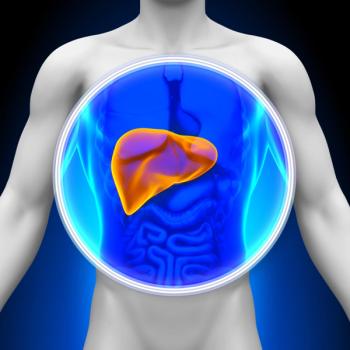
Pembrolizumab Plus Chemoradiotherapy as Total Neoadjuvant Therapy Unlikely to Benefit Patients With Advanced Rectal Cancer
Although pembrolizumab added to chemoradiotherapy was well tolerated in patients with stage II/III locally advanced rectal cancer, the neoadjuvant rectal score vs FOLFOX/chemoradiotherapy suggest that further study into its utility in this setting may not be supported.
Further study is not encouraged for pembrolizumab (Keytruda) added to chemoradiotherapy as total neoadjuvant therapy (TNT) for patients with locally advanced rectal cancer (LARC), according to a study from JAMA Oncology.
Previous investigation from this phase 2 study (NCT02921256) had suggested this treatment option was safe for this indication, however the neoadjuvant rectal (NAR) scores did not support the findings.
“The addition of pembrolizumab to chemoradiotherapy as part of TNT in LARC did not demonstrate our prespecified improvement in the primary end point of NAR score compared with FOLFOX and chemoradiotherapy alone,” said investigators of the study.
In this study, 185 patients were randomized to receive control therapy (n = 95) of FOLFOX—or 5-fluorouracil, leucovorin, and oxaliplatin—plus chemoradiotherapy or pembrolizumab plus chemoradiotherapy (n = 90). It was reported that 60 patients (66.7%) in the pembrolizumab arm had bulky disease compared with 55 (57.9%) in the control arm. However, 22 patients (23.2%) on the control had T4 disease versus the pembrolizumab arm with only 19 patients (21.1%).
The primary end point was change in the NAR score with secondary end points of overall survival, disease-free survival, and rate of pathologic complete response (pCR).
The control was given 6 cycles of FOLFOX followed by chemoradiotherapy consisting of twice-daily capecitabine at 825 mg/m2 concurrently with 4500 cGy in 25 fractions for 5 weeks plus a 540-cGy boost in 3 fractions starting 3 to 4 weeks after FOLFOX. Patients in the pembrolizumab group received 200 mg of pembrolizumab and the same chemoradiotherapy regimen every 3 weeks with treatment starting on day 1 of chemoradiotherapy for up to 6 doses. For 8 to 12 weeks after the last dose of radiotherapy, patients underwent surgery.
Patients who started radiotherapy and received 6 doses of pembrolizumab made up 45.7% (37 of 81) of the active therapy arm whereas 21 (25.9%) received 5 doses, 21 (25.9%) received 1 to 4 doses, and 2 (2.5%) did not receive any pembrolizumab.
In patients who had a resected tumor, 137 of 138 had valid NAR scores and complete pathologic assessment. The mean NAR score was 11.53 (standard deviation [SD], 12.43; 95% CI, 8.54-14.51) in the pembrolizumab arm (n = 69) versus 14.08 (SD, 13.82; 95% CI, 10.74-17.43) in the control arm (n = 68). Investigators found that the difference of 2.55 was not statistically significant (P=.26).
There were 12 patients who had missing pathologic assessment and invalid NAR scores. The mean modified NAR score with pembrolizumab (n = 76) was 11.52 (SD, 12.85; 95% CI, 8.59-14.46) versus 13.70 (SD, 14.21; 95% CI, 10.47-16.93) with the control (n = 77). Again, the difference of 2.17 was not statistically significant (P=.32). Investigators did find a higher pCR rate in the pembrolizumab arm (31.9%; 95% CI, 21.2%-44.2%) compared with the control arm (29.4%; 95% CI, 19.0%-41.7%), but the finding was not statistically significant (P = .75).
The clinical complete response rate based on presurgical staging was 13.9% (95% CI, 7.2%-23.6%) with pembrolizumab versus 13.6% (95% CI, 7.0%-23.0%) with control therapy (P = .36). Those who did undergo tumor resection had a lower sphincter-sparing rate with pembrolizumab at 59.4% (95% CI, 46.9%-71.1%) versus 71% (95% CI, 58.8%-81.3%) with the control which was not statistically significant (P = .15). Investigators are still studying long-term outcomes such as disease-free survival and overall survival.
Some adverse effects (AEs) of grade 3/4 were slightly increased in the pembrolizumab group during and after chemoradiotherapy, at 48.2% versus 37.3% in the control arm. With pembrolizumab, immune-related AEs were reported in 35 patients (43.2%), with 3 (3.7%) being grade 3 and no grade 4 or 5 events.
Reference
Rahma OE, Yothers G, Hong TS, et al. Use of total neoadjuvant therapy for locally advanced rectal cancer: initial results from the pembolizumab arm of a phase 2 randomized clinical trial. JAMA Oncol. Published online July 1, 2021. doi:10.1001/jamaoncol.2021.1683
Newsletter
Stay up to date on recent advances in the multidisciplinary approach to cancer.
































































































